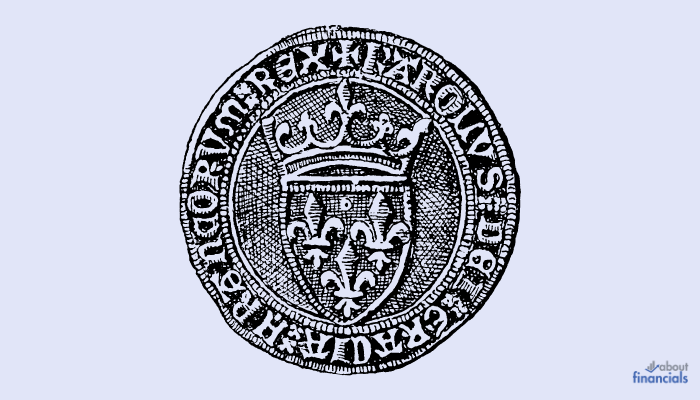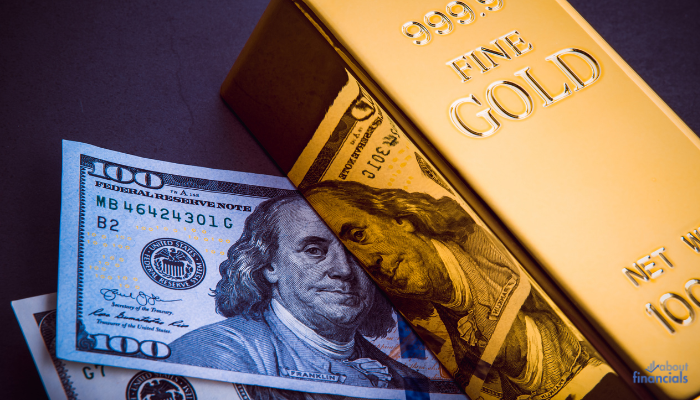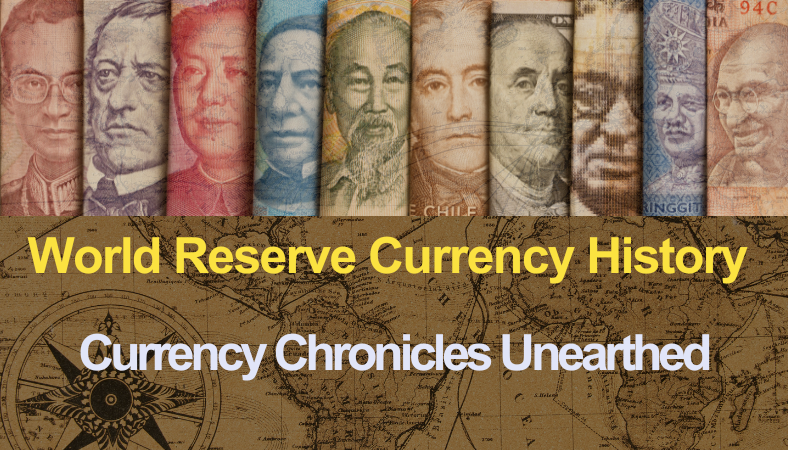A world reserve currency is the anchor of international transactions, a currency that nations hold in substantial quantities as part of their foreign exchange reserves.
This currency’s stature extends beyond its country of origin, impacting economies, trade relationships, and geopolitical dynamics on a global scale.
In this article, we will explore the fascinating history of these currencies, tracing their origins, transformations, and the impact they’ve had on the global financial landscape.
Early concepts of reserve currencies
Before the advent of modern fiat currencies, civilizations devised various ways to facilitate trade and store value. Early examples of reserve-like systems revolved around commodities that held intrinsic value. These commodities, often rare and universally desired, formed the basis for trade and exchange.

From the days of ancient civilizations to the medieval era, societies traded in commodities like grain, salt, and livestock. These items were tangible and held value due to their practical utility. Over time, precious metals, particularly gold and silver, emerged as the favored mediums of exchange and stores of value.
The historical significance of gold and silver extended beyond their practical use. They were durable, divisible, and relatively scarce, making them ideal candidates to serve as a universal measure of wealth. As trade expanded across borders, the need for a standardized medium of exchange became apparent. This paved the way for the era of gold and silver as the earliest forms of reserve currencies.
World Reserve Currency History – from 1450 AD
Since the year 1450, the history of world reserve currencies can be divided into six distinct periods. These periods were characterized by the prominence of specific countries’ currencies in the global financial landscape. The sequence includes Portugal’s era from 1450 to 1530, followed by Spain’s dominance from 1530 to 1640, the Netherlands’ prominence from 1640 to 1720, France’s influence from 1720 to 1815, Great Britain’s reign from 1815 to 1920, and the ongoing period of the United States since 1921.
Notably, each of these periods spanned an average of about 94 years. Remarkably, the United States dollar has held the status of the world’s primary reserve currency for approximately 99 years, making it a significant player in the international monetary system.
France as the World Reserve Currency Holder (1720-1815)
In the late 18th century, the Dutch East India Company’s financial crisis, caused mainly by its engagement in the War against the British Empire in Asia, resulted in bankruptcy. Subsequently, France underwent a republican transformation after the tulip mania bubble. The nation invaded the Netherlands, assuming control and introducing the predominant trade currency.

During this period, the issuance of the Assignat, a paper currency, marked the financial landscape. Introduced in 1789 amid the French Revolution’s start, the Assignat responded to France’s dire situation—marked by immense debt, widespread famine, and rural uprisings. These events, noted by the American Numismatic Association, showcase the intricate interplay of economic pressures, political shifts, and monetary innovations during this transformative period.
The British Pound Sterling era (1815 – 1920)
The British Empire, at the height of its influence during the 19th century, had a far-reaching impact on global trade and economics. The pound sterling, backed by Britain’s industrial prowess and expansive colonial holdings, emerged as a dominant reserve currency. The empire’s vast trading network, coupled with its naval power, facilitated the widespread use of the pound in international transactions.

The establishment of the gold standard further solidified the pound’s position as a world reserve currency. Under the gold standard, the value of a country’s currency was tied to a specific amount of gold, ensuring stability and predictability in exchange rates. This framework bolstered the pound’s credibility and facilitated smoother trade between nations.
However, the golden era of the pound as a reserve currency was not without its challenges. The two World Wars, along with economic upheavals, weakened Britain’s economic standing and strained the stability of the pound. The eventual decline of the British Empire and the emergence of new global players paved the way for a new contender to take center stage in the world of reserve currencies.
The U.S. as the World Reserve Currency Holder (1921-Present)
The aftermath of World War II marked a turning point in the history of world reserve currencies, with the emergence of the United States as an economic powerhouse. The Bretton Woods Agreement, established in 1944, formalized the U.S. dollar as the world’s primary reserve currency and laid the foundation for a new global monetary order.

Under the Bretton Woods system, countries agreed to peg their currencies to the U.S. dollar, which in turn was convertible to gold at a fixed rate. This arrangement provided a sense of stability and predictability to international trade, as the value of major currencies remained relatively constant.
The U.S. dollar’s ascendancy was fueled by the nation’s strong economic position after the war. The United States boasted a robust industrial base, advanced technological capabilities, and a relatively untouched infrastructure. These factors, coupled with the U.S. dollar’s convertibility to gold, enhanced its appeal as a reserve currency.
Throughout the latter half of the 20th century, the U.S. dollar’s dominance in international finance was unrivaled. Its status as the preferred medium of exchange for commodities like oil further solidified its position. However, the gold standard’s stability was challenged by economic pressures and an imbalance of trade, leading to its eventual abandonment in the early 1970s.
Despite the end of the gold standard, the U.S. dollar’s role as the primary reserve currency persisted, owing to its economic strength, widespread use, and the absence of a better alternative. The dollar’s influence extended beyond economics, encompassing geopolitical power and diplomatic negotiations.
Challenges and Shifts in the Reserve Currency Landscape
The 20th century witnessed a series of significant events that challenged the status quo of the U.S. dollar’s dominance as the world’s reserve currency. One pivotal moment came in 1971 when President Richard Nixon announced the suspension of the dollar’s convertibility to gold, effectively ending the Bretton Woods system. This marked the beginning of a new era in global finance.
The abandonment of the gold standard led to increased volatility in exchange rates and raised questions about the stability of the global monetary system. It also paved the way for the emergence of alternative reserve currencies. The European Economic Community’s efforts to establish the euro as a potential contender gained traction, culminating in the euro’s introduction in 1999.
The euro’s creation marked a significant step toward diversifying the reserve currency landscape. Backed by a large and integrated market, the euro aimed to provide a strong alternative to the U.S. dollar. Its adoption by multiple European nations signaled a collective effort to challenge the dollar’s monopoly.
Moreover, the rise of emerging economies, particularly China, brought new contenders into the reserve currency arena. The Chinese yuan, also known as the renminbi, gained attention as China’s economic might grew. China’s influence in global trade and finance prompted discussions about the yuan’s potential to become a significant reserve currency.
Contemporary Reserve Currency Dynamics
In the present day, the landscape of reserve currencies continues to evolve, driven by a combination of economic, technological, and geopolitical factors. While the U.S. dollar remains the dominant reserve currency, the emergence of new contenders and the changing nature of global trade are reshaping the dynamics of this realm.
One notable player in this evolving landscape is the Chinese yuan, or renminbi (RMB). China’s rapid economic growth and its position as a global manufacturing and trading hub have propelled the yuan onto the international stage. China’s efforts to internationalize the yuan involve promoting its use in cross-border trade settlements, investment, and as a reserve asset.
The yuan’s inclusion in the International Monetary Fund’s (IMF) Special Drawing Rights (SDR) basket in 2016 marked a significant milestone, symbolizing its growing recognition as a global reserve currency. This move reflects both China’s economic strength and the desire to reduce reliance on the U.S. dollar in international transactions.
Pros and Cons of Different Reserve Currencies
Being a world reserve currency comes with both advantages and drawbacks, influencing the economic and geopolitical strategies of nations. Let’s explore the benefits and challenges associated with holding this esteemed position.
Benefits:
- Global Influence: A reserve currency gives its issuing nation considerable influence in global financial markets, trade negotiations, and international policy discussions.
- Stability: Nations holding reserve currencies enjoy relative economic stability due to increased demand for their currency, which helps maintain lower interest rates and control inflation.
- Trade Facilitation: Reserve currencies simplify international trade by providing a common medium of exchange, reducing the need for constant currency conversions.
- Investment Appeal: Investors seek out reserve currencies for their stability and liquidity, bolstering a nation’s financial markets and attracting foreign investments.
Challenges:
- Exchange Rate Volatility: Reserve currencies often experience fluctuations in value, impacting both domestic and international markets.
- Trade Imbalances: Nations with reserve currencies can face pressure to maintain trade deficits to meet global demand for their currency, potentially leading to economic imbalances.
- Dependence on Issuer: Countries relying heavily on a single reserve currency are vulnerable to changes in the issuing nation’s economic policies and geopolitical shifts.
- Geopolitical Tensions: The dominance of one reserve currency can lead to geopolitical tensions, as nations may seek alternatives to reduce their reliance on a single nation’s currency.
Future outlook and implications on World Reserve Currency History
As we peer into the future, the path of reserve currencies becomes an intricate puzzle shaped by economic shifts, technological advances, and geopolitical dynamics. While the current landscape is dominated by the U.S. dollar, the emergence of alternative currencies and the rapid evolution of technology introduce a degree of uncertainty.
Multipolar Currency System
In this scenario, a multipolar currency system could emerge, featuring a diverse range of reserve currencies. The Chinese yuan, euro, and potentially other digital currencies could share the stage with the U.S. dollar. Such a system could promote greater stability, as no single nation would hold overwhelming influence.
Digital Dominance
The rise of central bank digital currencies (CBDCs) could revolutionize the reserve currency landscape. If CBDCs gain widespread acceptance, they might reshape the way nations conduct international transactions, potentially reducing the dominance of traditional fiat currencies.
Hybrid Solutions
Nations might adopt hybrid solutions that blend traditional reserve currencies with digital alternatives. This could involve the use of blockchain technology to enhance transparency, efficiency, and security in cross-border transactions.
Unforeseen Disruption
The future is unpredictable, and unforeseen disruptions—be they economic, geopolitical, or technological—could fundamentally reshape the reserve currency landscape. Innovation and crisis often go hand in hand, leading to unexpected shifts in the financial order.
Final thoughts
From the ancient use of commodities to the dominance of the U.S. dollar, each chapter in this story offers insights into the evolution of the modern financial system.
As we look ahead, the ever-changing landscape of reserve currencies invites us to ponder the future of money, trade, and diplomacy. The choices made by nations will continue to mold the economic destiny of the world, shaping the financial framework that underpins global prosperity and stability.
The history of world reserve currencies is evident to the fascinating correlation of economics, politics, and power on the global stage.

